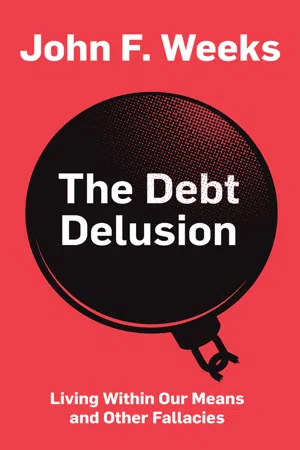Economics
Budget Balance
Budget balance refers to the difference between a government's total revenue and its total expenditure over a specific period, typically a fiscal year. A positive budget balance indicates a surplus, meaning that revenue exceeds expenditure, while a negative balance indicates a deficit. The budget balance is a key indicator of a government's fiscal health and its ability to meet financial obligations.
Written by Perlego with AI-assistance
Related key terms
2 Key excerpts on "Budget Balance"
- eBook - ePub
The Debt Delusion
Living Within Our Means and Other Fallacies
- John F. Weeks(Author)
- 2020(Publication Date)
- Polity(Publisher)
The “balance the books” cliché subsumes several issues about budgets rarely made explicit. To take two obvious ones: what should be balanced, and over what time period? Conventional answers to these questions are that total revenue should equal total spending and that balancing should be an annual goal. Both answers are arbitrary, with little or no analytical or practical justification. The next section pursues the question of what should be balanced. With regard to time span, most national governments have procedures organized around annual budgets, with these procedures set by long practice with no obvious technical basis.The characteristics of spending and tax categories do not lend themselves to matching over a specific time period such as twelve months. While this does not in itself negate the putative imperative to balance the budget, it should leave one skeptical about assigning great importance to annual outcomes. Discussions of budget balancing (total revenue = total expenditure) over any time period typically treat expenditure and tax as undifferentiated amounts rather than as a combination of elements with various characteristics and different functions. To make further progress, we take apart (“disaggregate”) both taxing and spending.Budget Uncertainty
Concern about whether governments should balance their books too often proceeds as if both tax and spending were totals that governments can accurately plan and achieve. The presumption that governments control spending and tax outcomes leads to the expectation that the balance between the two, the surplus or deficit, is also well within the power of governments to control. With this presumption of predictability and control, the media frequently take politicians to task for “not meeting their targets,” especially targets for deficit reduction.In practice, total spending, total tax revenue and the balance between them are uncertain outcomes over which the taxing and spending government has less than full control. The root cause of the lack of control is the interactive nature of what the government does and the response of the economy, and vice versa. As developed in greater detail below, government tax and spending policies affect the ebb and flow of private economic activity; and the ebb and flow of private economic activity feed back on public spending and tax revenue. - eBook - ePub
Macroeconomic Theory
A Dynamic General Equilibrium Approach - Second Edition
- Michael Wickens(Author)
- 2012(Publication Date)
- Princeton University Press(Publisher)
figure 5.1 , which plots government expenditures as a proportion of GDP for the United States and for the United Kingdom since 1901. Real government expenditures on goods and services and real social security benefits as a proportion of GDP have increased considerably over the last century. In 1901 they were only 2.3% of GDP for the United States and 13.5% for the United Kingdom. In most Western countries they increased from around 10–20% of GDP prior to World War I to around 40–50% after World War II. The wars themselves were the times of the greatest expansion in government expenditures. Since World War II, the shares of government expenditures in GDP have risen steadily and, apart from unemployment benefits, which vary countercyclically over the business cycle, they are not much affected by the business cycle. On average, the expenditures on goods and services and on transfers are roughly equal in size. Total government expenditures also include interest payments on government debt.Government revenues are primarily tax revenues: direct taxes on incomes and expenditure, social security taxes, and corporate taxes. The balance varies somewhat between countries, but for most developed countries direct taxes and social security taxes—which are in effect taxes on incomes—are about 60% of total tax revenue, consumption taxes are about 25%, and corporate taxes are about 10%. The average tax rate on incomes (including social security) is around 42%. Tax revenues tend to be more affected by the business cycle than expenditures. This is the main reason why government deficits tend to increase during a recession.As previously noted, governments can raise additional revenues through borrowing from the public or borrowing from the central bank, i.e., by printing money. The government simply extends its overdraft on its account with the central bank, which cashes checks issued to the public by the government.It is common in macroeconomics without microfoundations, such as Keynesian macroeconomics, to treat government expenditures as having no welfare benefits. They are included simply to allow fiscal policy to be included in the analysis and to allow the size of the fiscal multiplier to be calculated. In the standard Keynesian model this is the effect on GDP of a discretionary change in government expenditures. As this is tantamount to buying goods and services and then throwing them away—or, as Keynes himself noted, burying them— this is not a satisfactory formulation of fiscal policy. In our analysis we start by including government expenditures in the household’s utility function. We then discuss the issue of the optimal level of government expenditures. This is followed by an analysis of public finances: how best to pay for government expenditures and satisfy the government budget constraint. We also examine optimal tax policy, optimal debt, and the sustainability of fiscal deficits (the fiscal stance) in the longer term. At the end of the chapter we summarize our findings on the best way to manage fiscal policy.
Learn about this page
Index pages curate the most relevant extracts from our library of academic textbooks. They’ve been created using an in-house natural language model (NLM), each adding context and meaning to key research topics.

